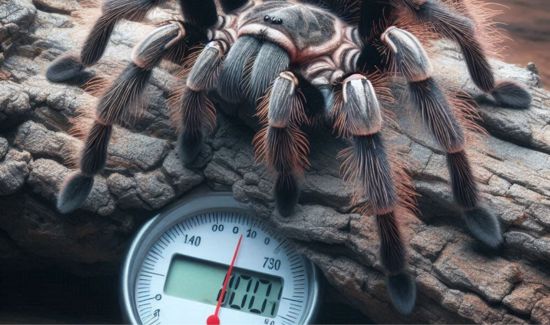Introduction
Table of Contents
Tarantulas are fascinating creatures that capture our imagination with their size, unique appearance, and intriguing behaviors. As one of the largest spiders in the world, tarantulas have been the subject of numerous myths and stories. This article will explore how much does a tarantula weigh, the factors that influence their weight, and other interesting aspects of these giant arachnids. Whether you are a curious reader, a budding arachnologist, or someone with a budding interest in the natural world, this article will satisfy your curiosity with facts and figures about these mysterious arachnids.

Tarantula Weight Basics
How Much Does a Tarantula Weigh?
A tarantula’s weight can vary significantly depending on its species, age, and gender. On average, most tarantulas weigh between 15 and 85 grams (0.5 to 3 ounces). For a spider, this weight is relatively heavy, considering some smaller tarantula species weigh less than 10 grams.
Species Variation
Heavyweight Tarantulas
The Goliath birdeater (Theraphosa blondi) is the heaviest tarantula species and one of the heaviest spiders in the world. It can weigh up to 170 grams (6 ounces). The salmon pink birdeater (Lasiodora parahybana) is another heavyweight, often weighing around 100 grams (3.5 ounces).
Lightweight Tarantulas
On the other hand, some tarantula species, like the Chilean rose tarantula (Grammostola rosea), tend to be on the lighter side, typically weighing around 15 to 20 grams (0.5 to 0.7 ounces).
Factors Influencing Tarantula Weight
Diet
Tarantulas are carnivorous and primarily feed on insects, small mammals, and even small birds. Their diet greatly influences their weight, with a diet rich in nutrients contributing to a heavier spider. Tarantulas are known to be opportunistic eaters, taking advantage of food when available. A well-fed tarantula will be heavier than one with a restricted diet.
Age and Maturity
As tarantulas grow, they shed their exoskeletons through a process called molting. Juvenile tarantulas are lighter and gradually gain weight as they mature. Molting allows them to grow in size, and with each molt, they may become heavier.
Gender Differences
In many tarantula species, females are generally larger and heavier than males. Females can live longer, often for several decades, while males have a shorter lifespan. The longer lifespan allows females to grow larger and accumulate more weight.
Understanding Tarantula Anatomy
Body Structure
Tarantulas have a robust and sturdy body structure that contributes to their weight. Their body consists of two main parts: the cephalothorax and the abdomen. The cephalothorax houses their eyes, mouthparts, and legs, while the abdomen contains their vital organs and silk-producing glands.
Legs and Weight Distribution
Tarantulas have eight legs that provide stability and mobility. These legs are crucial for supporting their body weight, and their muscular structure allows them to navigate their environment efficiently.
Exoskeleton
The exoskeleton is a protective outer shell that provides support and prevents water loss. It is a crucial component of a tarantula’s anatomy, contributing significantly to its overall weight.
Tarantula Weight in the Ecosystem
Predators and Prey
Tarantulas are both predators and prey within their ecosystems. Their weight allows them to overpower prey, but it also makes them a target for larger predators. Understanding their weight is essential for studying their ecological role and interactions with other species.
Adaptations
Tarantulas have evolved several adaptations to cope with their weight. Their strong legs and exoskeleton enable them to burrow, climb, and hunt effectively. These adaptations have allowed them to thrive in diverse environments, from rainforests to deserts.
Caring for a Tarantula: Weight Considerations
Monitoring Weight
For tarantula enthusiasts and pet owners, monitoring a tarantula’s weight is important for ensuring its health and well-being. Sudden changes in weight can indicate health issues or the need for adjustments in diet and habitat.
Providing a Balanced Diet
A balanced diet is crucial for maintaining a tarantula’s weight and overall health. Providing a variety of prey items ensures that they receive the necessary nutrients to thrive.
Appropriate Habitat
Creating an appropriate habitat for a tarantula is essential for their well-being. The enclosure should mimic their natural environment, providing enough space for them to move around comfortably and exercise their legs.
Table: How Much Does a Tarantula Weigh
| Tarantula Species | Average Weight (grams) | Average Weight (ounces) |
|---|---|---|
| Goliath birdeater | 170 | 6 |
| Salmon pink birdeater | 100 | 3.5 |
| Chilean rose tarantula | 15-20 | 0.5-0.7 |
| Mexican red-knee tarantula | 15-25 | 0.5-0.9 |
| Pink–toe tarantula | 20-30 | 0.7-1.1 |
Conclusion
Tarantulas are remarkable creatures with unique characteristics that make them stand out in the animal kingdom. Understanding their weight, anatomy, and role in the ecosystem helps us appreciate these fascinating spiders. Whether you are a seasoned arachnid enthusiast or just starting to explore the world of tarantulas, this article provides valuable insights into the world of these weighty arachnids. Remember, the next time you encounter a tarantula, you are looking at a creature perfectly adapted to its environment, both in size and weight.
FAQs about How Much Does a Tarantula Weigh
- How much does a tarantula weigh on average? Most tarantulas weigh between 15 and 85 grams (0.5 to 3 ounces) on average.
- Which is the heaviest tarantula species? The Goliath birdeater is the heaviest tarantula species, weighing up to 170 grams (6 ounces).
- Do female tarantulas weigh more than males? Yes, in many species, female tarantulas are larger and heavier than males.
- How does a tarantula’s diet affect its weight? A tarantula’s diet significantly influences its weight; a nutrient-rich diet contributes to a heavier spider.
- Why is it important to monitor a pet tarantula’s weight? Monitoring a tarantula’s weight helps ensure its health and well-being, as sudden changes can indicate health issues.

